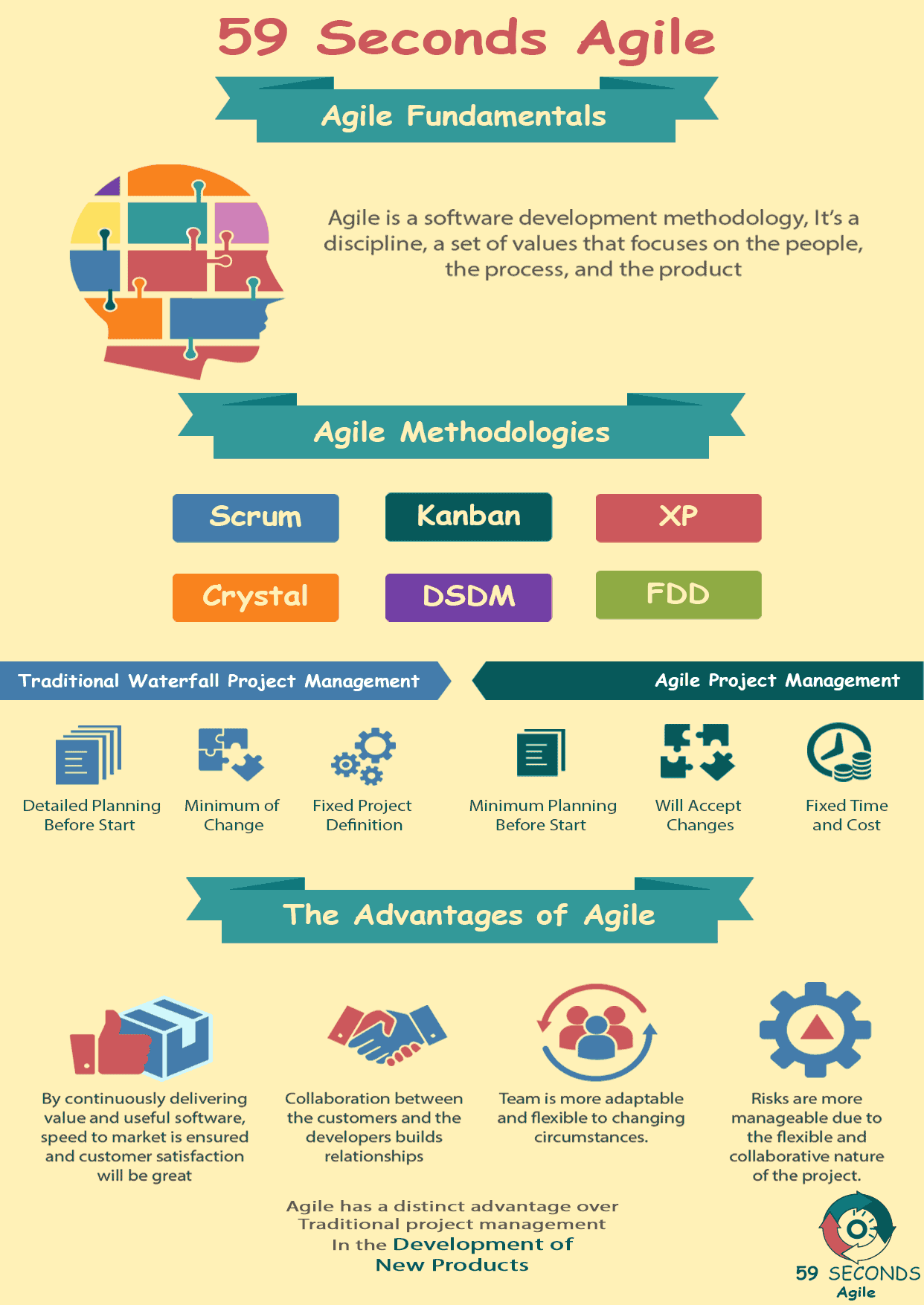This article discusses the Agile Values and Principles and focusses on the Product Owner perspective within the descriptions. The article also covers the Agile Manifesto and discusses what that is.
The Agile Fundamentals
A 59 Seconds Agile Video Animation
Agile Values and Principles for Product Owners
A 59 Seconds Agile Article
The Agile software development concept was introduced for rapid software development and to reduce the overhead of traditional software processes.
The Agile concept is based on a light and quick way of managing a project and facilitates the movement through changes. In comparison with traditional software development where everything is defined from the beginning like in waterfall model, this approach is based on iterative and incremental development. Though the Agile concept can be applied for management of any type of project, it was a group of software practitioners that proposed four key values and 12 principles for Agile software development under the name of the Agile manifesto in 2001.

Agile Values and Principles for Product Owners: Agile Manifesto
This manifesto proposes “better ways in developing software” and values “individuals and interactions over processes and tools”, “working software over comprehensive documentation”, “customer collaboration over contract negotiation” and “responding to change over following a plan”. In other words, the Agile values and principles require customer involvement, incremental delivery, focusing on people, not processes and embracing changes.

Agile Values And Principles
Applying the Agile values and principles in an organization improves the speed to market for the product and increases flexibility in terms of unpredictable nature of market or customer requirements by embracing the change. It also reduces the degree of risk in the product. In this approach, there is no outside governance and the team is self-organizing and cross-functional. Scrum is one of the different Agile frameworks. The Scrum guide defines different roles and ceremonies in the Agile approach to fulfill the proposed values. These roles are the Product owner, scrum master and the development team.
The Product Owner Adding Value to Sprints
At the beginning of each sprint and release, he reminds the team of goals and vision of the product thus making the team aware of the overall roadmap of the product. At the end of each sprint, he examines the progress of the product. He is the person who can accept if a story is done. He defines the acceptance criteria and validates that acceptance test is done and meets the DoD (Definition of Done). Focusing on delivering a functional increment of software required by the customer at the end of each sprint he values working software over comprehensive documentation (second value of Agile manifesto). In this way, he optimizes the return on investment(ROI). He also assures the level of quality of the work. In different Agile ceremonies, he can optionally attend stand-up meetings, but he participates in sprint planning and sprint review meetings.
Our Favourite Agile Books
We found these books great for finding out more information on Agile Scrum:
Agile Values And Principles: The Customer
The Product owner is in direct contact with customers and stakeholders. He builds and maintains a constant relationship with stakeholders. He talks to them to find out what they value and what they expect, fulfilling the fourth value of Agile manifesto (valuing customer collaboration over contract negotiation). The Product owner gets the feedback from customers and creates new requests for the sprint planning sessions. In this way, he assures the continuous improvement of the product regarding the third value of Agile manifesto (valuing responding to change over following a plan). If a strategic change is required, he is the only person that can change the direction of the product at the end of the sprint. He can also terminate a sprint if the current items in the product backlog are not in line with the required change.
Agile Values And Principles: Success
To assure the success of the product owner, his decisions should be respected by the entire organization. These decisions are visible and transparent through the product backlog items. In large organizations when different teams work on different related products, for each product, one product owner is assigned. These product owners should talk to each other to organize the teams and backlogs to minimize dependencies. In this case, Chief Product Owner role is introduced to keep the product owners synchronized and avoid any conflict or overhead.
Prev <— Continue Reading —> Next
User Stories Applied
A 59 Seconds Agile Book Review
User Stories Applied by Mike Cohn is one of our favourite books on Agile User Stories. The book starts with an overview into user stories, and details what a user story is and the different aspects of them. He then discusses how to go about writing a user story, and provides details of the INVEST criteria that can be used to determine if the story is meeting all of its objectives. Next Mike gives an in depth discussion of who user stories are written for and where to begin when gathering the details for them. The book then discusses acceptance testing user stories, including how to go about specifying these criteria and the responsibilities of the development team and customers during this process.
Prev <— Continue Reading —> Next
Learn More
Agile Project Management Training Courses
Agile Fundamentals
A 59 Seconds Agile Infographic


